#badjao
Explore tagged Tumblr posts
Text

aura.
3 notes
·
View notes
Text
Sitangkai: the Philippines’ southern frontier
Over the weekend, I found myself at the southernmost edge of the Philippines—Sitangkai, a remote municipality in Tawi-Tawi that lies closer to Malaysia than to Zamboanga or even Sulu's Jolo. Often dubbed the "Venice of the South", Sitangkai earns this moniker from its intricate network of waterways, where boats—not wheels—serve as the primary mode of transportation. But beyond this passing resemblance to the famed Italian city, Sitangkai holds a quiet charm that is entirely its own.



Sitangkai’s waterways converge at the so-called 'Boulevard'—a broad canal that stretches from the village’s main entry point, marked by a distinct welcome arch, all the way to the Municipal Hall at its farthest reach.
Set among islands and shoals that once sat at the heart of ancient maritime trade routes, Sitangkai has long been home to the Sama-Bajaus—our seafaring brothers and sisters who have thrived for generations through fishing and cross-island trade. Life here moves to the rhythm of the tides, and the culture is rich with traditions shaped by the surrounding Sulu and Celebes seas.



At certain times of the day, traders line the edges of the Boulevard, their wooden boats brimming with goods—from fresh vegetables and fruits to the day’s catch of fish. Buyers gather as well, negotiating prices and making their own offers in a lively exchange. I was there at around 5 p.m., and the place was still buzzing with activity.
Today, Sitangkai’s strategic location continues to make it a vital trading port, serving as a gateway for goods moving between the Philippines and neighboring Malaysia. In its floating markets, currencies are flexible—and stories, traded just as easily as goods, flow freely from locals, traders, and visitors alike. Here, borders blur and cultures converge.



Just behind the Municipal Hall sits the local high school. A graduation ceremony was underway when I visited. I saw graduates and their parents dressed in some of the most beautiful attire I’ve ever seen at such an event—vibrant, elegant, and deeply expressive of pride. Their joy was unmistakable, and rightfully earned.
Indeed, Sitangkai stands as a quiet yet enduring reminder of the Philippines’ maritime roots—and of our deep, living ties with our Southeast Asian neighbors, carried not by wheels, but by the open waters that have long connected our histories, economies, and lives.



The heat in Sitangkai was intense—the kind that clings to your skin. Thankfully, a boat selling ice cream came by, offering a much-needed break from the swelter. But more than the heat, it’s Sitangkai—its beauty, its people, and their warm hospitality—that will cling to me far longer.
3 notes
·
View notes
Text
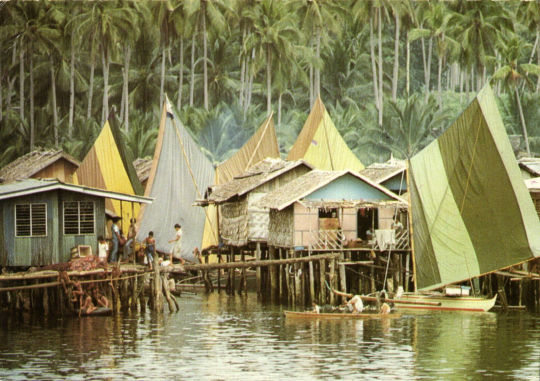
Badjao Village on Basilan Island, Philippines
Philippino vintage postcard
#vintage#philippines#tarjeta#briefkaart#postcard#photography#badjao#postal#carte postale#sepia#ephemera#island#philippino#historic#ansichtskarte#badjao village#postkarte#basilan#basilan island#village#postkaart#photo
8 notes
·
View notes
Text

5 notes
·
View notes
Text
HINDI NA MALILIGAW HINDI NA MALILIGAW HINDI NA MALILIGAW TININININININININININININININININIW DI NA MALILIGAW HINDI NA MALILIGAW HINDI NA MALILIGAW HINDI NA MALILIGAW
AKING SINTAAA
2 notes
·
View notes
Text

Burial marker selfie
Looking back at a Sunduk burial marker of the Sama Dilaut people, which was taken in the 1980s from Santa Cruz Island, Zamboanga City; and exhibited at the Museo ng Kalinangang Pilipino of the Cultural Center of the Philippines (CCP), in Pasay City.
The sunduk is a carved wooden grave marker used by the Badjao-Samal people, in the southern Philippines, and the bases are usually formed to represent boats that represent both the home and livelihood for these nomadic people. The sunduk’s “headstones” are usually carved in the floral motif called ukkil, while newer versions have the floral shapes painted on a flat piece of wood.
Traditionally, the Badjao-Samal people can be seen between the Zamboanga peninsula and the Sulu archipelago, but most “tribes” have been forced to end their nomadic lifestyles and settle in seaside communities that even reach to Metro Manila.
Santa Cruz Island is one of the many burial isles used by the Badjao-Samal people, but these places have been highly contested as many thieves desecrated the graves and have stolen the sunduk to sell to collectors. That is why newer sunduk do not have the ornate ukkil carvings to prevent theft.
Although the exact date of burial, the sunduk was acquired and integrated into the CCP collection before 1986, and it was showcased at the Museo ng Kalinangang Pilipino (Museum of Philippine Culture) permanent exhibition of Filipino artifacts from various traditional ethnographic groups upon its opening in 1987 until its closing in 2020.
This picture was taken circa 2015
#travel#history#filipinotraveller#philippines#philippinehistory#philippineculture#ccp#culturalcenterofthephilippines#badjao#samal#sunduk
0 notes
Text
Pêche sous-marine en apnée en eaux profondes [vidéo]
Nouvel article publié sur https://www.2tout2rien.fr/peche-sous-marine-en-apnee-en-eaux-profondes-video/
Pêche sous-marine en apnée en eaux profondes [vidéo]

0 notes
Text
On this day, July 16, 2025, IV of Spades has reunited.

After 7 years since Unique left the band to pursue his own music, and 5 years since their hiatus to pusue their own solo careers, IV of Spades came back with a beautiful ballad today.
I can't say I didn't see this coming. With Unique hanging out with Zild and Blaster more over the years, I knew that eventually, they'll have a come back. I just didn't expect it to be today. In a random Wednesday in July.
The harmonies of Zild and Unique's voices in a call-and-response style in the choruses and the second verse, the lyrics penned by the boys, and the melodies and beat made me feel like this is going to be a more mature sound of IVOS. Aura is just the beginning of it. Overall, the song is beautiful. I feel like I can go to sleep to this becauss it felt like a lullaby, like them saying, "we're finally here."
I'm excited how they'll mesh their styles this time. I hope the past never repeats itself because their styles would sound better if they let each other shine. I know that they will handle this new rebrand in a much better way, and I'm here for it. For all of it. I'm excited to witness the new IV Of Spades.
To Blaster, Zild, Unique, and Badjao, I never gave up. I'm here for all of it. So, bring it.
#lazyyy thoughts#pinoy posting#filipino posting#OPM#original philippine music#iv of spades#ivos#zild benitez#badjao de castro#unique salonga#blaster silonga#spaders#Spotify
16 notes
·
View notes
Text

JUST REALIZED I NEVER POSTED THIS HERE nationality hcs :]
#PIKERO'S CANONICALLY VIET IN CASE PEOPLE DON'T KNOW HE'S SO DEAR TO ME AND IM NOT EVEN VIET#arupek is too filipino coded its scary#badjao is an indigenous group mostly known as “sea nomads” and their culture revolves around the sea and fishing btw#aru speaks a bit of bisaya and a mindanao dialect (idk which one im sorry)#chaco forgets which words are spanish and which ones are filipino so he mixes them up#bado grew up in africa so his filipino is very conyo/taglish#british hallritt is the reason his cooking is bad i fear#fragaria memories#fragmem#fragaria memories headcanon#hallritt#merold#puruth#romarriche#rimicha#sanah#cielomort#kurode#willmesh#klarkstella#louterstella#myunna#badobarm#chaco#arupek#tuxam#hangyon#pikero#>> quincyposting
42 notes
·
View notes
Text
IVOS Random Thoughts #5
Imagine if there's a continuation from the MV of Come Inside of My Heart: Unique joining them in the car and the spades at the side of the windshield are complete.


#ivos#iv of spades#unique salonga#zild benitez#blaster silonga#badjao de castro#come inside of my heart#what if#imagine
0 notes
Text









On my birthday nag work lang ako up until 4am and treated it like a normal day. Kase hindi ko pa tanggap na 29 na ako? Grabe lumalabas na din ang mga sakit sakit sa katawan.
On the next day went outside to eat with Ally and solid talaga ang bacsilog shet. Natuwa din ako kase kumain si ally ng spaghetti kahit once in a blue moon yan.
Tumambay lang kami sa beach hanggang mag 7pm.
I had a good encounter with one badjao kid. Bumili kase kami ni ally ng stickers sa mr.diy then nakatingin yung bata. I gave her two pages and sobrang happy and thank you lang sya ng thank you. Even yung papa nya nag thank you. After that she decided to give yung isang toy nya kay ally (she only had 3 toys inside the plastic bag). Like girl i wanna cryyyy kase that was so pure. Imagine having almost nothing pero willing siya ibigay yung one of the toys na meron lang sya 🥹. Binalik ko sa kanya kase iniisip ko baka yun na lang nilalaro nya eh madami naman toys si ally. Stickers lang naman yun for me pero i made someone damn happy.
Like why can life be that way? Sobrang memorable ng birthday ko kase i had that memorable encounter. In this world full of selfish people, why can we be that kid. 😭😭
Wala lang ang drama ko lang pero i love it so much. Maybe it’s God’s way of telling me to be more grateful for all the blessings and to have a heart just like that little kid.
20 notes
·
View notes
Text
MALAYBALAY CITY (MindaNews / 10 December) – The Bangsamoro Parliament unanimously approved the Bangsamoro Indigenous Peoples Act (BIPA) of 2024 on its third and final reading during a special session on Tuesday, according to a press release from the regional legislative body’s Publication and Media Relations Division.
The law, which was passed with 63 votes in favor, zero against, and no abstentions, “has been recognized as a historic success in the region’s ongoing peace process and commitment to inclusive governance.”
BIPA recognizes the IP’s ownership over their ancestral domains, referred to as fusaka ingëd, and natural resources in these territories.
The press release quoted Ramon Piang, chair of the committee on Indigenous Peoples affairs as saying that the BIPA is an enhanced version of the Indigenous Peoples’ Rights Act, “specifically designed to meet the unique needs of the Bangsamoro’s indigenous population.”
Indigenous Peoples in the Bangsamoro Autonomous Region in Muslim Mindanao (BARMM) include the non-Moro IPs (Téduray, Lambangian, Dulangan Manobo, Erumanun Ne Menuvu, Higaonon, B’laan), and the Badjao, Sama Dilaut, Jama Mapun, Sama Bangingi, and Sama Pangutaran in the island provinces of Basilan, Sulu and Tawi-Tawi.
The Supreme Court, however, has ruled with finality on Sulu’s removal from BARMM. (MindaNews)
39 notes
·
View notes
Text
Barter lives on in Batu-Batu
Every Saturday in the town of Panglima Sugala in Tawi-Tawi, the age-old practice of barter comes vividly to life.
I was in Barangay Batu-Batu just in time for Adlaw Pagtabuh-tabuh, a weekly market where trading is done through barter—a system in which goods are exchanged for other goods, rather than for money. It felt surreal to witness something I had only read about in history books now unfolding before me.




Once the capital of Tawi-Tawi, Batu-Batu saw the seat of government transferred to the nearby town of Bongao in the late 1970s. But despite this political transition, the barangay remains a vital hub of local life. Many Sama-Badjaus continue to reside here, while others return regularly on market days.
Batu-Batu is surrounded by fertile lands, dense forests, and rich coastal waters—all vital sources of sustenance and livelihood for the Sama-Badjaus. The quaint barangay—and Panglima Sugala more broadly—continues to serve as an important commercial hub for the province.
Batu-Batu feels timeless, where tradition is not merely preserved but actively woven into the fabric of daily life. Here, barter isn't a staged cultural display, but a functional and enduring mechanism of community exchange and social cohesion.




Tawi-Tawi stands as the Philippines’ largest producer of seaweed, anchoring the livelihoods of many coastal communities across the province. Locally known as agal-agal, seaweed is harvested and either sold fresh—often tossed into vibrant, flavorful salads—or dried and stored in warehouses before being transported to larger markets like Zamboanga City for industrial use.
Both the seafaring and shoreline Sama-Badjaus sail in with wooden boats laden with reef fish, shellfish, and seaweed harvested from the Sulu and Celebes Seas. Likewise, farming Sama-Badjaus from the island interiors bring root crops, vegetables, coconuts, bananas, and other produce to trade.
Transactions are simple and sincere—no cash passes from one hand to another; only goods are exchanged, guided by mutual need, deep trust, and generations of tradition.
#Tawi-tawi#Panglima Sugala#Batu-Batu#Bongao#Adlaw Pagtabuh-tabuh#Barter#Philippines#Sama-Bajau#Badjao#Mindanao
0 notes
Text

TMP: Filipino 🇵🇭 (Badjao)
These folks literally live on water, she would be besties with Moana... wait... today is Moana 2 premiere--
12 notes
·
View notes
Text
Let's talk about Elsweyr's architecture, specifically how geography influenced it.
In the Elder Scrolls Online base game, players can visit Kenarthi's Roost, which is the starting location for Aldmeri Dominion players. We could easily observe the stilted houses and buildings on the island of the Khajiits. This doesn't really reflect the nomadic culture that majority of the beastfolk have since these kinds of buildings are made to last and are built for prolonged stay in the area. How do I know this?

As a Filipino, I find this style of building especially familiar. Indonesians may also share the same sentiment. In the real world, these stilted buildings are known as "bahay kubo" in the Philippines. They are a staple of provincial life and are designed in a way that prevents floodwater and mud from entering the house. This is why they are built on stilts.
Another purpose of stilt houses is to decrease the occurrence of pests running into the houses. Tropical countries are known for the many insects and small mammals that inhabit them, and stilt houses can help to keep these pests out.
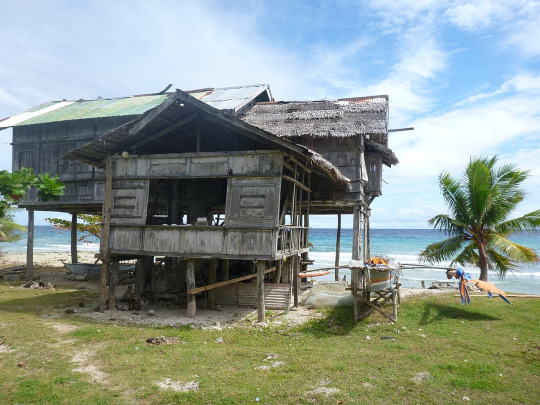
As you can see from the image above, it is quite different from the fantasy world. It is a Filipino stilted house from the Siquijor region. The roof is not exaggerated, and the windows are more open. However, the buildings from Kenarthi Roost are actually very based on real life.
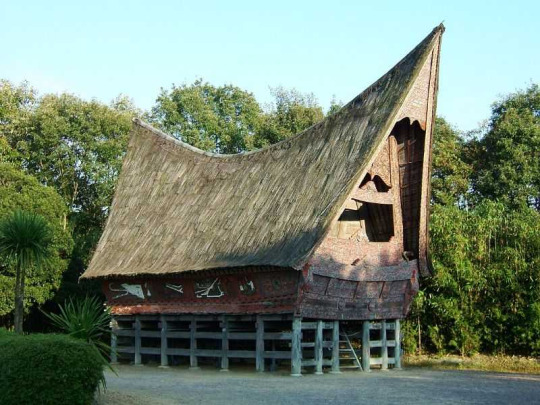
Looking at the image, it is clear where the makers of the game got their inspiration. This is an Indonesian stilted house. The purpose of this kind of roofing is to let the water slide down in times of heavy rains. Observe the stilts on this house, and you can see that they have more support compared to the ones from the Philippines.
Basically, stilt houses are raised off the ground, which allows for better airflow and helps to keep the house cooler. Additionally, the stilts can be used to create a ventilated space underneath the house, which can help to lower humidity levels.
It can also help to regulate temperature and reduce humidity is the use of natural materials. Materials such as wood, bamboo, and thatch are good insulators, which helps to keep the house cool in the dry season and warm in the wet season. Additionally, these materials are porous, which allows for good airflow and helps to prevent moisture build-up.

In this pre-release image, we can see that the columns and stilts are made of stone, and the motifs of the buildings are reminiscent of the styles from Cambodia and its surrounding regions.
Adding to that, the region of Southeast Asia is characterized by heavy rains and storms. In the more tropical parts of Elsweyr, stilted houses are more common. However, as you go up north, the climate becomes less tropical and more temperate, and the houses become less stilted and more made of stone.
Below are some comparisons of Elsweyr to Southeast Asian locations (left is Elsweyr, right is the Southeast Asian location):

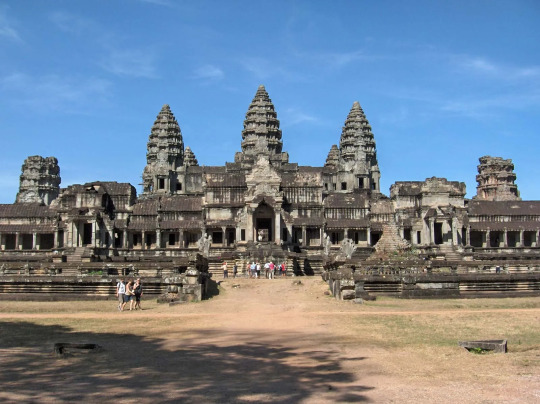
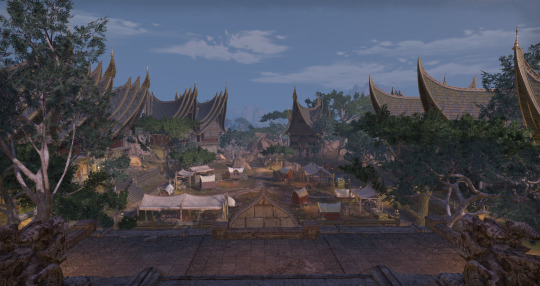

The similarities are quite evident.
While some references say that the Khajiit are based on the Romanian peoples of Europe, their architecture is very much based on Southeast Asian styles. It is also worth noting that traces of Persian, Romani, Indian, and other cultures can be found in Khajiit society.
Some YouTube content also states that the Khajiit can be compared to gypsies in the real world, as they are both considered "fringe people." Another note regarding the architecture is that it is also based on the domiciles of the sea gypsies in the Philippines, the Badjaos.
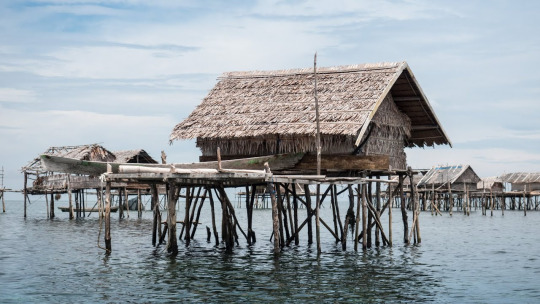
Southeast Asia is a very beautiful region with a great deal of cultural diversity. As someone from the Philippines, I can say from my own experience that foreigners can experience how Western and Eastern cultures merge here.
What other topics should I do next?
#Tamrielic Tales#Gaming#the elder scrolls#elder scrolls online#tes online#skyrim#lore#deep dive#elsweyr#khajiit#south east asia#philippines#indonesia
98 notes
·
View notes
Text
IV Of Spades just came back.
So, in honor of their new release "Aura," here's a bootleg version of its cover art. Made by yours truly :D


while this is the original cover
STREAM AURA BY IV OF SPADES!!
0 notes